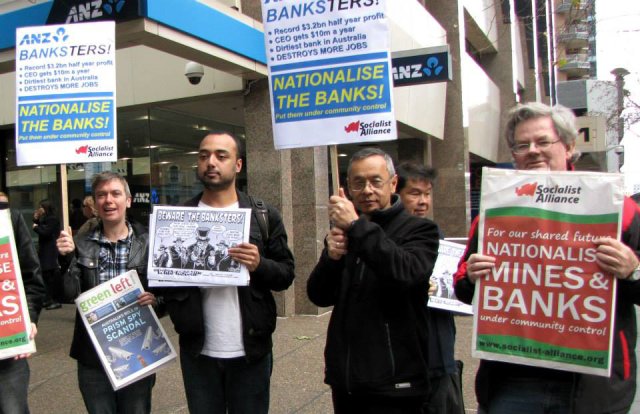
Earlier this year, US and European banks — the ones that were too big to fail — settled US$18 billion worth of fines with regulators.
These fines were for money laundering activities, breaching sanctions violations, and manipulating the Libor (London interbank offered rate). The Libor is used to set interest rates on about US$800 trillion of borrowings and derivative contracts.
On November 12 five banks, including Citi and JP Morgan, agreed to pay fines to regulators in the US, Britain and Switzerland totalling US$4.3 billion for manipulating the foreign-exchange market which turns over US$5.3 trillion a day.
Whistle-blowing bank employees had alerted the authorities to this criminal behaviour several years ago but nothing was done until last year.
The British regulator, the Bank of England, was complicit in the cover-up. Senior official, Martin Mallet, knew about the attempted currency manipulation for several years but did nothing to prevent it. He had strong links to some of the foreign-exchange traders who were involved in what was politely described as “misconduct”. He was eventually dismissed last week.
Coincidentally, the Bank of England is trying to restart the loan securitisation market. This involves the packaging of loans into separate entities and then selling securities backed by those loans to third-party investors.
It was the selling of these products, wrapped up with subprime mortgages, that was responsible for many of the worst excesses of the global financial crisis (GFC) that has been with us since 2008.
When regulators treat criminal behaviour with all the seriousness of a littering offence, it is no surprise that the big banks treat the regulators with equal contempt.
The British Financial Conduct Authority actually offers banks a 30% discount on fines if the banks agree to pay up promptly.
The British bank Barclays declined this offer over allegations that it was involved with the other five banks in manipulating the foreign-exchange market.
It is, in effect, betting up to $180 million on getting a bigger discount by dealing with the British, US and other regulators simultaneously while the US Justice Department is investigating whether market manipulation is a crime under US law.
As the Australian Institute reported on November 14, Australia’s big four banks, ANZ, Commonwealth, Westpac and NAB control more of the country’s banking share than the biggest four local banks anywhere in the world. Their underlying pre-tax profit for the year is $44 billion, but little is said of the more than $13 trillion in off-balance-sheet derivatives which they were exposed to at the start of the GFC.
All four banks have been subject to a class action over late credit card fees which have been ruled illegal by courts in the initial legal action. But only the NAB has moved to settle its obligations.
At its annual general meeting last week, the Commonwealth Bank’s explanation for its failure to control their dodgy financial planning department — where about 400,000 customers were exposed to unethical advice — was that it was “distracted by the GFC”.
When the Senate was inquiring into the collapsed managed investment scheme with the ANZ-linked Timbercorp last week, the ANZ was unable to send a representative because it said it could not afford to — this from a bank whose profits in the financial year to October increased by 15% to $7.3 billion.
At least some of ANZ’s profits are said to come from the sale of exotic financial products known as Collateralised Debt Obligations (CDOs).
These were sold to local councils resulting in them losing millions of dollars. Several of these councils, including Coffs Harbour City Council, have filed documents in the Federal Court alleging that ANZ held a substantial number of CDO’s on its balance sheet and had an interest in the successful sale of CDO’s to the councils as any unsold CDO’s would expose ANZ to investment losses.
ANZ will now join the Commonwealth Bank who are also accused of a conflict of interest and misleading and deceptive conduct over the sale of toxic CDO’s to Gloucester Shire Council.
There is a similar mechanism to the Libor that is used for setting business lending rates and pricing derivatives transactions between institutions in Australia. It is known as the Bank Bill Swap Rate (BBSW) and is set by a panel of 14 banks. Last year, an inquiry by the Singapore Monetary Authority into the setting of these rates raised concerns about the ANZ and Macquarie banks.
This led to an investigation by the Australian Securities and Investment Commission (ASIC) into the manipulation of the BBSW by local banks. The first casualty is ANZ, who stood down seven staff in its market division last November.
Alleged market rigging by the big banks is cartel-type behaviour, which is a criminal offence in Australia. But one thing you can bet on is that if any of the 14 banks are found guilty of market manipulation the penalty will be a small fine.
Australia managed its way through the GFC in better shape than most countries thanks to the Keynesian counter-cyclical economic policies that were implemented here and in China.
In Australia these included unlimited guarantees of bank deposits and wholesale funding. This led to the big four banks that were too big to fail getting bigger.
One result of the GFC has been that banks around the world have been required to lift their capital adequacy requirements so as to ameliorate the effects of any future economic downturn.
The big four in Australia have resisted this because it takes capital away from their dodgy investments and reserves it as part-insurance against future losses. They have threatened to claw back any increase in money reserves they will be required to hold by raising interest rates.
Several countries are debating the issue of breaking up large banks. A better idea would be to nationalise them.
Like the article? Subscribe to Green Left now! You can also like us on Facebook and follow us on Twitter.